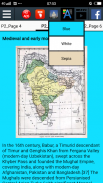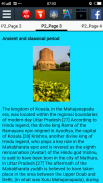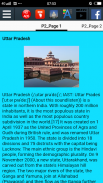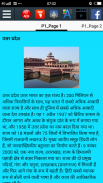










उत्तर प्रदेश का इतिहास - History of Uttar Pradesh

Description of उत्तर प्रदेश का इतिहास - History of Uttar Pradesh
(English)
Uttar Pradesh is a state in northern India. With roughly 200 million inhabitants, it is the most populous state in India as well as the most populous country subdivision in the world.[17] It was created on 1 April 1937 as the United Provinces of Agra and Oudh during British rule, and was renamed Uttar Pradesh in 1950. The state is divided into 18 divisions and 75 districts with the capital being Lucknow. The main ethnic group is the Hindavi people, forming the demographic plurality. On 9 November 2000, a new state, Uttarakhand, was carved out from the state's Himalayan hill region. The two major rivers of the state, the Ganga and Yamuna, join at Allahabad (Prayagraj) and then flow as the Ganga further east. Hindi is the most widely spoken language and is also the official language of the state.
The state is bordered by Rajasthan to the west, Haryana, Himachal Pradesh and Delhi to the northwest, Uttarakhand and Nepal to the north, Bihar to the east, Madhya Pradesh to the south, and touches the states of Jharkhand and Chhattisgarh to the southeast. It covers 243,290 square kilometres (93,933 sq mi), equal to 7.33% of the total area of India, and is the fourth-largest Indian state by area. The economy of Uttar Pradesh is the fourth-largest state economy in India with ₹15.79 lakh crore (US$230 billion) in gross domestic product and a per capita GDP of ₹57,480 (US$830).[13] Agriculture and service industries are the largest parts of the state's economy. The service sector comprises travel and tourism, hotel industry, real estate, insurance and financial consultancies. President's rule has been imposed in Uttar Pradesh ten times since 1968, for different reasons and for a total of 1,700 days.[18] Uttar Pradesh ranks twenty eighth among Indian states in human development index.[15]
The natives of the state are generally called Uttar Bhartiya,[citation needed] or more specifically either Awadhi, Bageli, Bhojpuri, Braji, Bundeli, Kannauji, or Rohilkhandi depending upon their region of origin. Hinduism is practised by more than three-fourths of the population, with Islam being the next largest religious group. Uttar Pradesh was home to powerful empires of ancient and medieval India. The state has several historical, natural, and religious tourist destinations, such as Agra, Ayodhya, Vrindavan (Mathura), Varanasi and Allahabad.
(हिन्दी)
उत्तर प्रदेश का भारतीय एवं हिन्दू धर्म के इतिहास मे अहम योगदान रहा है। उत्तर प्रदेश आधुनिक भारत के इतिहास और राजनीति का केन्द्र बिन्दु रहा है और यहाँ के निवासियों ने भारत के स्वतन्त्रता संग्राम में प्रमुख भूमिका निभायी।
उत्तर प्रदेश के इतिहास को निम्नलिखित पाँच भागों में बाटकर अध्ययन किया जा सकता है-
(1) प्रागैतिहासिक एवं पूर्ववैदिक काल (६०० ईसा पूर्व तक),
(2) हिन्दू-बौद्ध काल (६०० ईसा पूर्व से १२०० ई तक),
(3) मध्य काल (सन् १२०० से १८५७ तक),
(4) ब्रिटिश काल (१८५७ से १९४७ तक) और
(5) स्वातंत्रोत्तर काल (1947 से अब तक)।

























